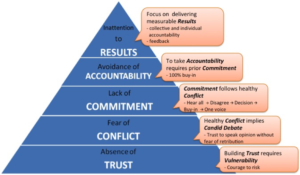Is everyone pulling in the same direction? And do their behaviours match their words and the mission and values of your organisation? Remember the culture of your organisation is the sum total of leadership behaviours, so there are few, if any, things more important than getting your top team pulling in the same direction.
Below is the 5 Dysfunctions model by Patrick Lencioni. It is a fantastic model to start thinking about your team and how effective it is.
(Click on graphic to enlarge)
A quick overview of the 5 Dysfunctions Model
The true measure of a team is that it accomplishes the results that it sets out to achieve. To do that on a consistent, ongoing basis, a team must overcome the five dysfunctions listed here by embodying the behaviours described for each one.
Dysfunction 1: Absence of Trust:
Members of great teams trust one another on a fundamental, emotional level. They are comfortable being vulnerable with each other about their weaknesses, Mistakes, fears, and behaviours. They get to a point where they can be completely open with one another, without filters. This is essential because:
Dysfunction 2: Fear of Conflict:
Teams that trust one another are not afraid to engage in passionate dialogue around issues and decisions that are key to the organisation’s success. They do not hesitate to disagree with, challenge, and question one another, all in the spirit of finding the best answers, discovering the truth, and making great decisions. This is important because:
Dysfunctions 3: Lack of Commitment:
Teams that engage in unfiltered conflict are able to achieve genuine buy-in around the important decisions, even when various members of the team initially disagree. That’s because they ensure that all opinions and ideas are put on the table and considered, giving confidence to team members that no stone has been left unturned. This is critical because:
Dysfunction 4: Avoidance of Accountability:
Teams that commits to decisions and standards of performance do not hesitate to hold one another accountable for adhering to those decisions and standards. What is more, they do not rely on the team leader as the primary source of accountability; they go directly to their peers. This matters because:
Dysfunction 5: Inattention to Results:
Teams that trust one another, engage in conflict, committed decisions, and one another accountable are very likely to set aside their individual needs and agendas and focus almost exclusively on what is best for the team. They do not give in to the temptation to place their departments, career aspirations, or ego-driven status ahead of the collective results that define team success.
Verbatim, p7. Overcoming the Five Dysfunctions of a Team. Patrick Lencioni
Please click on this link if you would like to think further about the unifying purpose of your team

